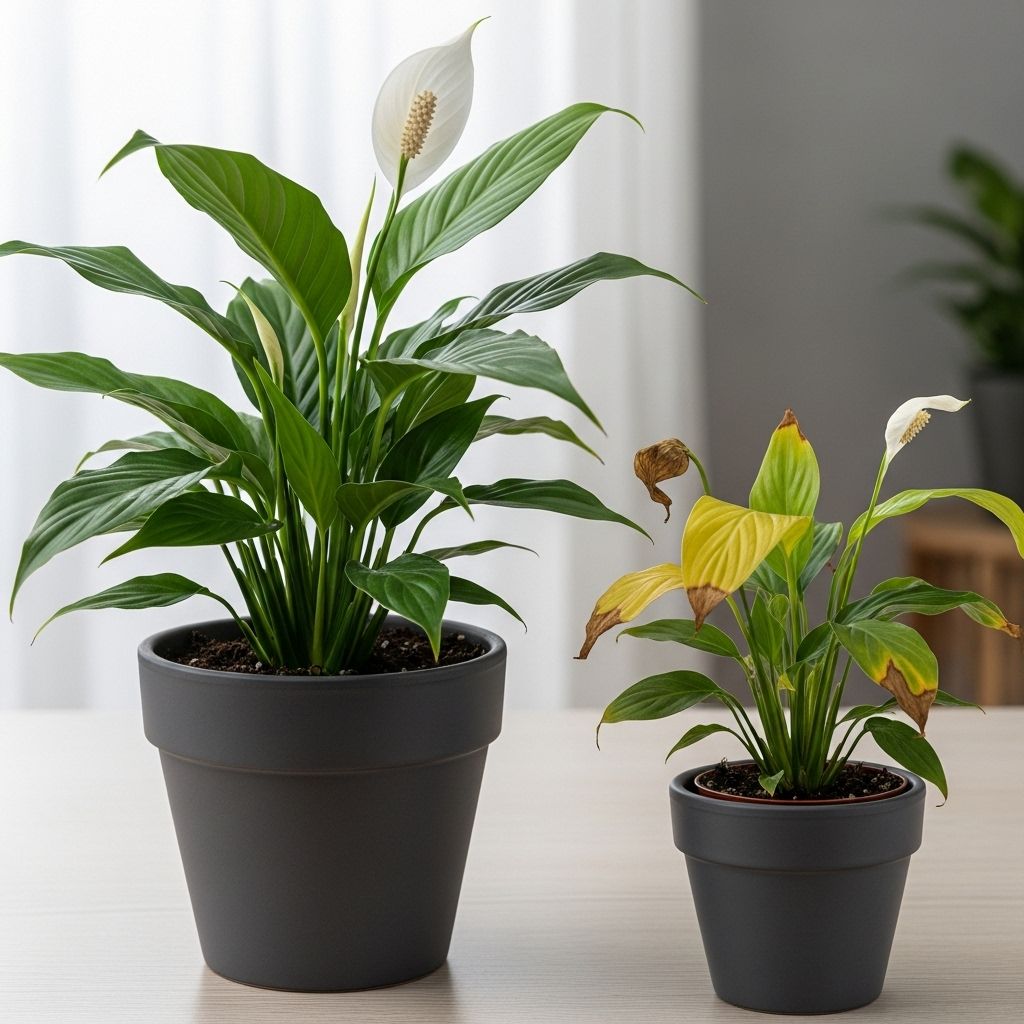Peace Lily Problems: 15 Easy Fixes For Common Issues
Troubleshoot common Peace Lily issues with this expert guide—from yellowing leaves to root rot, learn causes, cures, and prevention.

Image: HearthJunction Design Team
15 Common Problems With Peace Lily Plants and How to Fix Them
Peace Lilies (Spathiphyllum) are among the most popular indoor plants, prized for their elegant white blooms and air-purifying qualities. While they are considered easy to care for, even seasoned growers face occasional issues. Understanding the common Peace Lily problems, their causes, and solutions is essential for keeping your plant healthy and thriving.
Contents
- Introduction
- Solid Yellow Leaves
- Brown Tips
- Drooping Leaves
- Leaf Spots & Black/Brown Splotches
- Wilting & Underwatering
- Root Rot
- Pest Infestations
- Lack of Blooms
- Small or Stunted Leaves
- Curling Leaves
- Green-Tinged or Fading Flowers
- Transplant Shock
- Becoming Rootbound
- Temperature & Humidity Problems
- Prevention & Houseplant Best Practices
- Frequently Asked Questions
Why Do Peace Lilies Struggle?
Often mistaken as invincible, Peace Lilies prefer specific conditions to truly flourish. Common issues stem from neglect, improper watering, poor light, and infrequent fertilizing. Recognizing early warning signs gives you the chance to fix problems before they compromise the plant’s health.
Solid Yellow Leaves
Yellow leaves are the most frequent issue faced by Peace Lily owners. Yellowing typically starts at the base of the plant and progresses up the stem.
- Causes: Overwatering, underwatering, or poor drainage. Sometimes, natural leaf aging or direct sunlight can also contribute.
- Fix: Check the soil moisture with your finger; only water when the top 1–2 inches are dry. Remove affected leaves with sterilized scissors. Ensure the pot has proper drainage holes and use a well-draining soil mix.
- Prevention: Water consistently and avoid soggy soil. Avoid placing the plant in direct sunlight. Repot if roots are crowded or the soil is exhausted.
Brown Tips
Brown, crispy leaf tips are unsightly but usually easy to fix.
- Causes: Excess minerals or chlorine/fluoride from tap water, over-fertilizing, low humidity, or underwatering can all cause brown tips.
- Fix: Water with filtered or rainwater. If you must use tap water, let it sit overnight to dissipate chlorine. Trim brown tips with sterilized scissors. Reduce fertilizer frequency and flush the soil periodically with distilled water to remove mineral buildup.
- Prevention: Maintain moderate humidity (50–60%), and avoid over-fertilizing. Use high-quality water for irrigation whenever possible.
Drooping Leaves
Droopy, limp leaves signal that your Peace Lily is unhappy, but it’s not necessarily a death sentence.
- Causes: Most often underwatering, but can also be a sign of overwatering or recent temperature stress.
- Fix: Test soil moisture—if dry, water thoroughly and expect the plant to perk up within hours. If soil is soggy, allow it to dry out, then adjust your watering routine.
- Prevention: Water consistently and keep the plant away from cold drafts or heat sources.
Leaf Spots & Black/Brown Splotches
Dark patches can be alarming. These spots often begin as small yellow areas that darken over time, sometimes with a water-soaked appearance.
- Causes: Fungal or bacterial infection, especially when leaves are kept wet. Overhead watering and persistently humid leaves are risk factors.
- Fix: Remove all affected leaves and dispose of them. Repot in fresh, dry soil. Water the soil directly, not the leaves. In persistent cases, use a houseplant fungicide as directed.
- Prevention: Increase air circulation and avoid getting water on the foliage. Water in the morning so leaves dry by evening.
Wilting & Underwatering
Wilting leaves are thin and soft, often folding in on themselves.
- Causes: Underwatering is the usual culprit, but extreme overwatering resulting in root rot can produce similar symptoms.
- Fix: If soil is dry, water thoroughly and let excess drain away. If the plant does not recover, inspect roots for rot.
- Prevention: Observe regular watering and check soil weekly. Don’t let the plant sit in water.
Root Rot
| Sign | Likely Cause | Action |
|---|---|---|
| Mushy, brown roots | Overwatering, poor drainage | Remove all affected roots, repot in clean, dry mix |
| Foul-smelling soil | Bacterial/fungal infection | Change soil, sterilize pot, use fungicide if needed |
| Stunted growth | Root suffocation | Add perlite or bark to soil, improve drainage |
Pest Infestations
Pests rarely decimate a Peace Lily but can still cause problems.
- Common Pests: Spider mites, mealybugs, aphids, and scale insects.
- Fix: Shower the plant with lukewarm water to remove small pests. Wipe leaves with a damp cloth or cotton swab dipped in rubbing alcohol. Use insecticidal soap for persistent infestations.
- Prevention: Inspect new plants before bringing them home. Isolate affected plants and maintain good air circulation.
Lack of Blooms
Peace Lilies are known for their luxurious white flowers, but sometimes they simply won’t bloom.
- Causes: Insufficient light, lack of nutrients, or the plant is too young.
- Fix: Provide bright, indirect light. Feed with a balanced, diluted houseplant fertilizer every 4–6 weeks during spring and summer. Mature plants bloom more readily than young ones.
- Prevention: Keep the plant near a north- or east-facing window, and avoid nutrient exhaustion.
Small or Stunted Leaves
Smaller-than-normal leaves or slow growth can be disappointing.
- Causes: Low light levels, depleted soil, or root crowding.
- Fix: Relocate the plant to brighter, indirect light. Repot if roots fill the pot. Refresh the soil every 1–2 years.
- Prevention: Fertilize sparingly in the growing season and rotate the plant for even growth.
Curling Leaves
Leaves curling inwards or appearing “cupped” signal a stress response.
- Causes: Low humidity, underwatering, sudden temperature changes, or pests.
- Fix: Increase humidity, water as needed, and keep away from drafts. Check undersides of leaves for pests.
- Prevention: Use a humidity tray or room humidifier, and avoid sudden environmental shifts.
Green-Tinged or Fading Flowers
Peace Lily flowers naturally age to green or brown before dying, but premature color change can indicate a problem.
- Causes: Extreme lighting (too much or too little) or aging.
- Fix: Remove faded blooms. Adjust light exposure—move out of direct sun but keep in a well-lit spot.
- Prevention: Regularly deadhead old flowers to promote new blooms and use curtains to filter strong sunlight.
Transplant Shock
Repotting can temporarily stress your Peace Lily, resulting in wilt or leaf loss.
- Causes: Sudden change to root environment.
- Fix: Keep newly repotted plants in stable, indirect light. Do not fertilize immediately—give the plant several weeks to adjust before resuming feeding.
- Prevention: Repot in spring or summer, when the plant is actively growing, and disturb roots as little as possible.
Becoming Rootbound
When a Peace Lily becomes rootbound—roots circling the pot with little soil left—growth may stall, leaves yellow, and wilting becomes frequent.
- Signs: Roots exiting drainage holes, soil drying out too quickly.
- Fix: Repot into a container one size larger, use fresh potting mix, and gently loosen roots before replanting.
- Prevention: Inspect roots yearly, and repot every 1–2 years as needed.
Temperature & Humidity Problems
Peace Lilies thrive between 65–85°F (18–29°C) and with humidity levels of 50–60%.
- Signs of Trouble: Brown leaf edges, leaf curling, or slowed growth.
- Fix: Move away from heaters, air conditioner vents, or cold windows. Use a humidifier or humidity tray near the plant.
- Prevention: Keep the plant in a steady, draft-free location, and group with other houseplants for microclimate benefits.
Prevention & Houseplant Best Practices
- Check soil moisture before watering—Peace Lilies prefer to dry out slightly between waterings.
- Use well-draining, high-quality potting mix and ensure the pot has a drainage hole.
- Feed with a diluted, balanced fertilizer once every 1–2 months during active growth.
- Wipe leaves regularly to remove dust and discourage pests.
- Rotate the plant every few weeks for even growth.
Prevention is always better than treatment when it comes to plant care. Most Peace Lily problems, once fixed, do not return if you consistently provide the right environment and attentive care.
Frequently Asked Questions (FAQs)
Q: Why are my Peace Lily’s leaves turning yellow?
A: Overwatering is the most common reason, but underwatering, aging leaves, or root binding can also be responsible. Assess watering habits and soil drainage, and remove yellow leaves as needed.
Q: What should I do about brown tips on my Peace Lily?
A: Brown tips are often caused by excess minerals in tap water or over-fertilization. Switch to filtered or distilled water, flush soil regularly, and trim brown tips with sterilized scissors.
Q: How often should I water my Peace Lily?
A: Water your Peace Lily when the top 1–2 inches of soil are dry, typically every 7–10 days. Adjust frequency based on temperature, humidity, and pot size.
Q: Can Peace Lilies grow in low light?
A: Peace Lilies tolerate low to moderate light but bloom best in bright, indirect light. Avoid direct sunlight, which can scorch leaves.
Q: How do I get my Peace Lily to bloom?
A: Ensure the plant receives bright, indirect light and regular feeding with a balanced fertilizer during spring and summer. Mature plants are more likely to flower.
Q: Are Peace Lilies toxic to pets?
A: Yes, Peace Lilies contain calcium oxalate crystals and are toxic if ingested by cats, dogs, and humans. Keep them out of reach of curious pets and children.
By recognizing signs early and responding with the right fix, you can maintain a lush, healthy Peace Lily that rewards you with elegant leaves and blooms year-round.
References
- https://www.epicgardening.com/peace-lily-problems/
- https://www.youtube.com/watch?v=8LfFcGjjrlQ
- https://www.livelyroot.com/blogs/plant-care/troubleshooting-peace-lily-leaves-problems
- https://www.happyhouseplants.co.uk/blogs/houseplant-blog/help-my-peace-lily-is-drooping-common-causes-and-solutions
- https://www.pennington.com/all-products/fertilizer/resources/how-to-grow-and-care-for-a-peace-lily
Read full bio of Anjali Sayee












